MITSUBISHI OUTLANDER SPORT 2014 3.G Owners Manual
Manufacturer: MITSUBISHI, Model Year: 2014, Model line: OUTLANDER SPORT, Model: MITSUBISHI OUTLANDER SPORT 2014 3.GPages: 388, PDF Size: 20.04 MB
Page 181 of 388
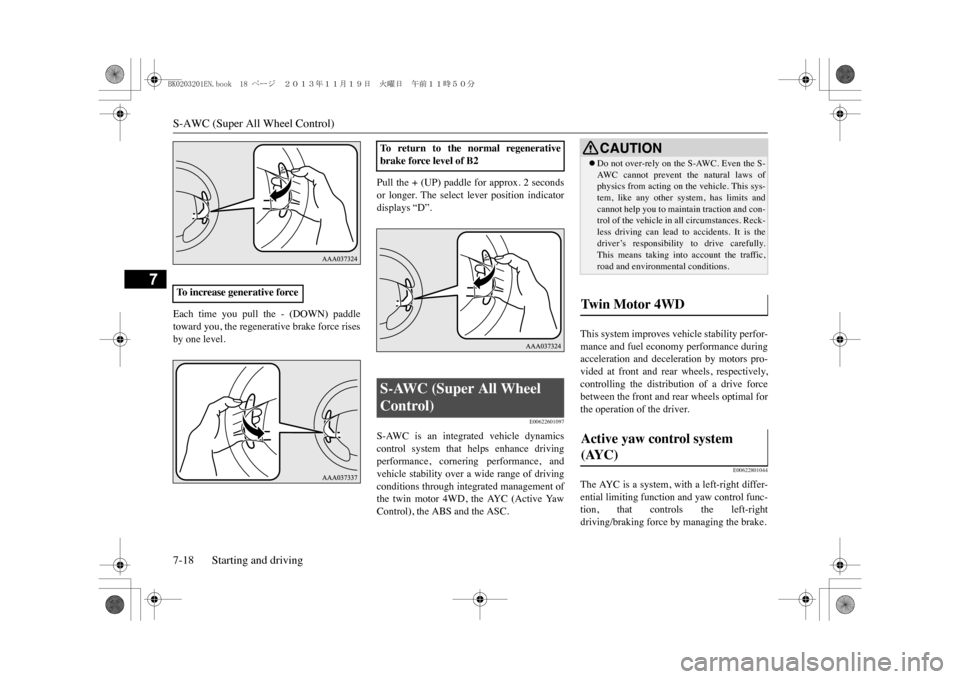
S-AWC (Super All Wheel Control)7-18 Starting and driving
7
Each time you pull the - (DOWN) paddletoward you, the regenerative brake force risesby one level.
Pull the + (UP) paddle for approx. 2 secondsor longer. The select lever position indicatordisplays “D”.
E00622601097
S-AWC is an integrated vehicle dynamicscontrol system that helps enhance drivingperformance, cornering performance, andvehicle stability over a wide range of drivingconditions through integrated management ofthe twin motor 4WD, the AYC (Active YawControl), the ABS and the ASC.
This system improves vehicle stability perfor-mance and fuel economy performance duringacceleration and deceleration by motors pro-vided at front and rear wheels, respectively,controlling the distribution of a drive forcebetween the front and rear wheels optimal forthe operation of the driver.
E00622801044
The AYC is a system, with a left-right differ-ential limiting function and yaw control func-tion, that controls the left-rightdriving/braking force by managing the brake.
To i n c r e a s e g e n e r a t i v e f o r c e
To r e t u r n t o t h e n o r m a l r e g e n e r a t i v ebrake force level of B2S-AWC (Super All Wheel Control)
CAUTION�zDo not over-rely on the S-AWC. Even the S-AW C c a n n o t p r e v e n t t h e n a t u r a l l a w s o fphysics from acting on the vehicle. This sys-tem, like any other system, has limits andcannot help you to maintain traction and con-trol of the vehicle in all circumstances. Reck-less driving can lead to accidents. It is thedriver’s responsibility to drive carefully.This means taking into account the traffic,road and environmental conditions.
Tw i n M o t o r 4 W D Active yaw control system (AYC)
BK0203201EN.book 18 ページ 2013年11月19日 火曜日 午前11時50分
Page 182 of 388
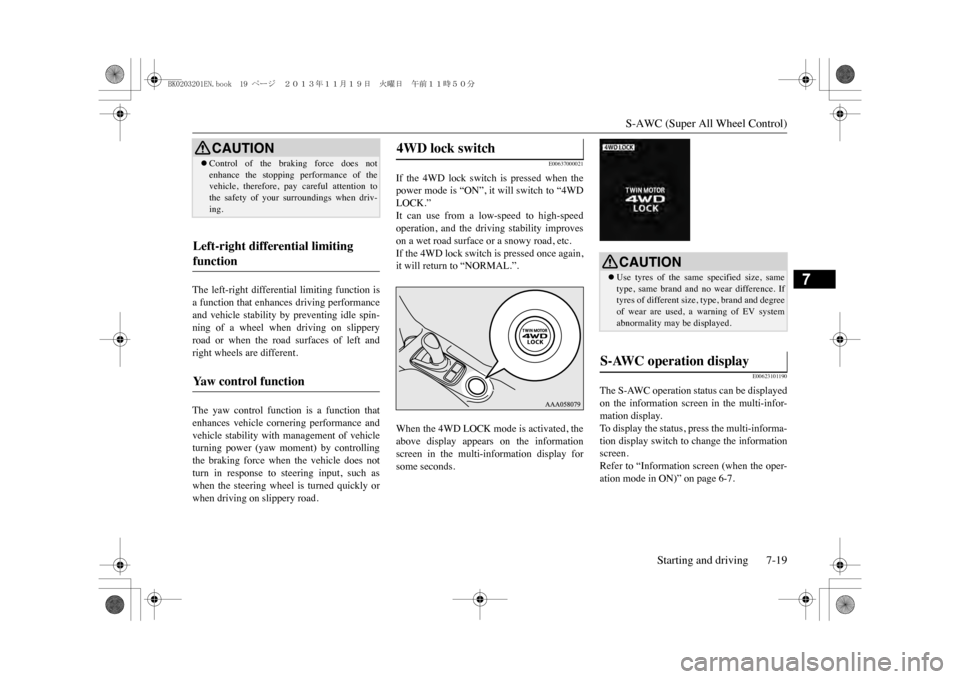
S-AWC (Super All Wheel Control)
Starting and driving 7-19
7
The left-right differential limiting function isa function that enhances driving performanceand vehicle stability by preventing idle spin-ning of a wheel when driving on slipperyroad or when the road surfaces of left andright wheels are different.The yaw control function is a function thatenhances vehicle cornering performance andvehicle stability with management of vehicleturning power (yaw moment) by controllingthe braking force when the vehicle does notturn in response to steering input, such aswhen the steering wheel is turned quickly orwhen driving on slippery road.
E00637000021
If the 4WD lock switch is pressed when thepower mode is “ON”, it will switch to “4WDLOCK.” It can use from a low-speed to high-speedoperation, and the driving stability improveson a wet road surface or a snowy road, etc. If the 4WD lock switch is pressed once again,it will return to “NORMAL.”. When the 4WD LOCK mode is activated, theabove display appears on the informationscreen in the multi-information display forsome seconds.
E00623101190
The S-AWC operation status can be displayedon the information screen in the multi-infor-mation display.To display the status, press the multi-informa-tion display switch to change the informationscreen.Refer to “Information screen (when the oper-ation mode in ON)” on page 6-7.
CAUTION�zControl of the braking force does notenhance the stopping performance of thevehicle, therefore, pay careful attention tothe safety of your surroundings when driv-ing.
Left-right differential limiting function Ya w c o n t r o l f u n c t i o n
4WD lock switch
CAUTION�zUse tyres of the same specified size, sametype, same brand and no wear difference. Iftyres of different size, type, brand and degreeof wear are used, a warning of EV systemabnormality may be displayed.
S-AWC operation display
BK0203201EN.book 19 ページ 2013年11月19日 火曜日 午前11時50分
Page 183 of 388
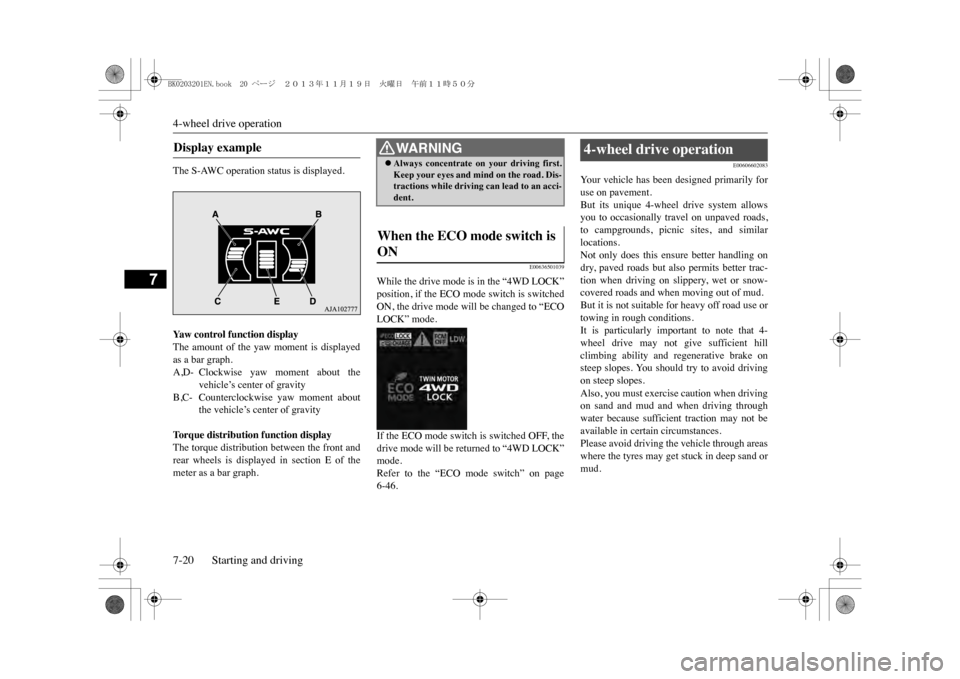
4-wheel drive operation7-20 Starting and driving
7
The S-AWC operation status is displayed.
E00636501039
While the drive mode is in the “4WD LOCK”position, if the ECO mo
de switch is switched
ON, the drive mode will be changed to “ECOLOCK” mode.If the ECO mode switch is switched OFF, thedrive mode will be returned to “4WD LOCK”mode.Refer to the “ECO mode switch” on page6-46.
E00606602083
Yo u r v e h i c l e h a s b e e n d e s i g n e d p r i m a r i l y f o ruse on pavement.But its unique 4-wheel drive system allowsyou to occasionally travel on unpaved roads,to campgrounds, picnic sites, and similarlocations.Not only does this ensure better handling ondry, paved roads but also permits better trac-tion when driving on slippery, wet or snow-covered roads and when moving out of mud.But it is not suitable for heavy off road use ortowing in rough conditions.It is particularly important to note that 4-wheel drive may not give sufficient hillclimbing ability and regenerative brake onsteep slopes. You should try to avoid drivingon steep slopes.Also, you must exercise caution when drivingon sand and mud and when driving throughwater because sufficient traction may not beavailable in certain circumstances.Please avoid driving the vehicle through areaswhere the tyres may get stuck in deep sand ormud.
Display example Ya w c o n t r o l f u n c t i o n d i s p l a yThe amount of the yaw moment is displayedas a bar graph.A,D- Clockwise yaw moment about the
vehicle’s center of gravity
B,C- Counterclockwise yaw moment about
the vehicle’s center of gravity
To r q u e d i s t r i b u t i o n f u n c t i o n d i s p l a yThe torque distribution between the front andrear wheels is displayed in section E of themeter as a bar graph.
WA R N I N G�zAlways concentrate on
your driving first.
Keep your eyes and mind on the road. Dis-tractions while driving can lead to an acci-dent.
When the ECO mode switch is ON
4-wheel drive operation
BK0203201EN.book 20 ページ 2013年11月19日 火曜日 午前11時50分
Page 184 of 388
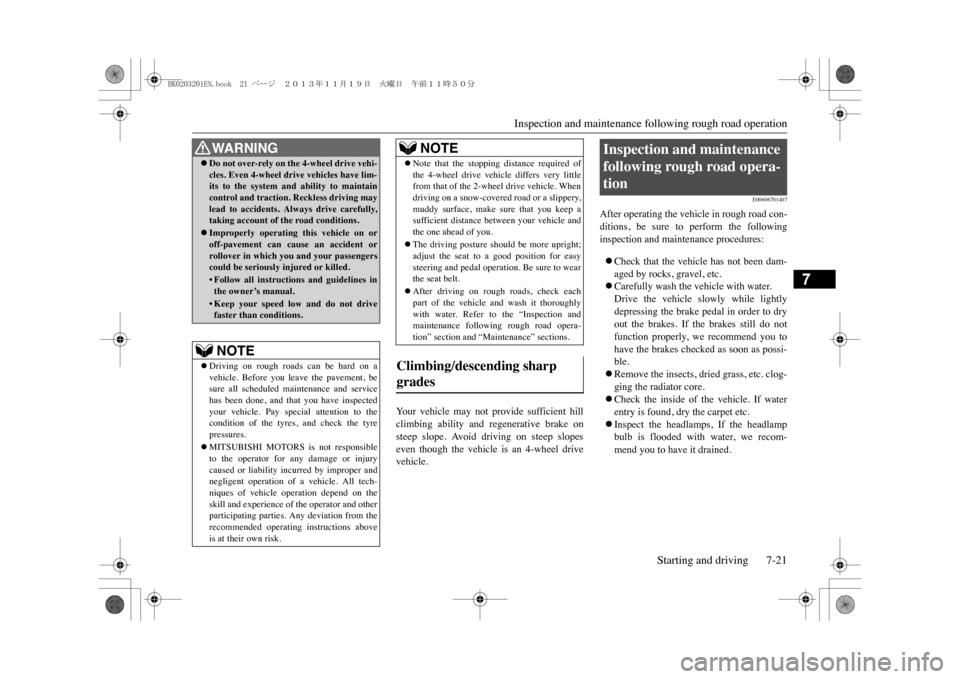
Inspection and maintenance following rough road operation
Starting and driving 7-21
7
Yo u r v e h i c l e m a y n o t p r o v i d e s u f f i c i e n t h i l lclimbing ability and regenerative brake onsteep slope. Avoid driving on steep slopeseven though the vehicle is an 4-wheel drivevehicle.
E00606701407
After operating the vehicle in rough road con-ditions, be sure to perform the followinginspection and maintenance procedures:�zCheck that the vehicle has not been dam-aged by rocks, gravel, etc.�zCarefully wash the vehicle with water.Drive the vehicle slowly while lightlydepressing the brake pedal in order to dryout the brakes. If the brakes still do notfunction properly, we recommend you tohave the brakes checked as soon as possi-ble.�zRemove the insects, dried grass, etc. clog-ging the radiator core.�zCheck the inside of the vehicle. If waterentry is found, dry the carpet etc.�zInspect the headlamps, If the headlampbulb is flooded with water, we recom-mend you to have it drained.
WA R N I N G�zDo not over-rely on the 4-wheel drive vehi-cles. Even 4-wheel drive vehicles have lim-its to the system and ability to maintaincontrol and traction.
Reckless driving may
lead to accidents. Always drive carefully,taking account of the road conditions.�zImproperly operating this vehicle on oroff-pavement can cause an accident orrollover in which you and your passengerscould be seriously injured or killed.•Follow all instructions and guidelines inthe owner’s manual.•Keep your speed low and do not drivefaster than conditions.NOTE
�zDriving on rough roads can be hard on avehicle. Before you leave the pavement, besure all scheduled maintenance and servicehas been done, and that
you have inspected
your vehicle. Pay special attention to thecondition of the tyres, and check the tyrepressures.�zMITSUBISHI MOTORS
is not responsible
to the operator for any damage or injurycaused or liability incurred by improper andnegligent operation of a vehicle. All tech-niques of vehicle operation depend on theskill and experience of the operator and otherparticipating parties.
Any deviation from the
recommended operating instructions aboveis at their own risk.
�zNote that the stopping
distance required of
the 4-wheel drive vehicle differs very littlefrom that of the 2-wheel
drive vehicle. When
driving on a snow-covered
road or a slippery,
muddy surface, make sure that you keep asufficient distance between your vehicle andthe one ahead of you.�zThe driving posture s
hould be more upright;
adjust the seat to a good position for easysteering and pedal operati
on. Be sure to wear
the seat belt.�zAfter driving on rough roads, check eachpart of the vehicle and wash it thoroughlywith water. Refer to the “Inspection andmaintenance following rough road opera-tion” section and “Maintenance” sections.
Climbing/descending sharp grades
NOTE
Inspection and maintenance following rough road opera-tion
BK0203201EN.book 21 ページ 2013年11月19日 火曜日 午前11時50分
Page 185 of 388
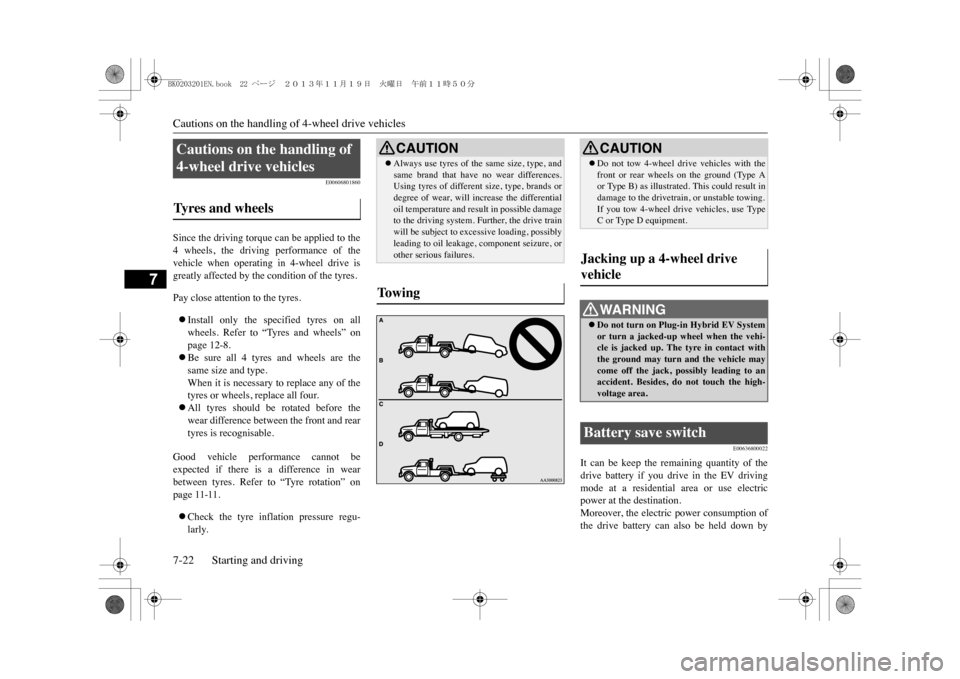
Cautions on the handling of 4-wheel drive vehicles7-22 Starting and driving
7
E00606801860
Since the driving torque can be applied to the4 wheels, the driving performance of thevehicle when operating in 4-wheel drive isgreatly affected by the condition of the tyres.Pay close attention to the tyres.�zInstall only the specified tyres on allwheels. Refer to “Tyres and wheels” onpage 12-8.�zBe sure all 4 tyres and wheels are thesame size and type.When it is necessary to replace any of thetyres or wheels, replace all four.�zAll tyres should be rotated before thewear difference between the front and reartyres is recognisable.
Good vehicle performance cannot beexpected if there is a difference in wearbetween tyres. Refer to “Tyre rotation” onpage 11-11.�zCheck the tyre inflation pressure regu-larly.
E00636800022
It can be keep the remaining quantity of thedrive battery if you drive in the EV drivingmode at a residential area or use electricpower at the destination.Moreover, the electric power consumption ofthe drive battery can also be held down by
Cautions on the handling of 4-wheel drive vehicles Ty r e s a n d w h e e l s
CAUTION�zAlways use tyres of the same size, type, andsame brand that have no wear differences.Using tyres of different size, type, brands ordegree of wear, will increase the differentialoil temperature and result in possible damageto the driving system. Further, the drive trainwill be subject to exce
ssive loading, possibly
leading to oil leakage, component seizure, orother serious failures.
To w i n g
CAUTION�zDo not tow 4-wheel driv
e vehicles with the
front or rear wheels on the ground (Type Aor Type B) as illustrated. This could result indamage to the drivetrain, or unstable towing.If you tow 4-wheel drive vehicles, use TypeC or Type D equipment.
Jacking up a 4-wheel drive vehicle
WA R N I N G�zDo not turn on Plug-in Hybrid EV Systemor turn a jacked-up wheel when the vehi-cle is jacked up. The tyre in contact withthe ground may turn and the vehicle maycome off the jack, possibly leading to anaccident. Besides, do not touch the high-voltage area.
Battery save switch
BK0203201EN.book 22 ページ 2013年11月19日 火曜日 午前11時50分
Page 186 of 388
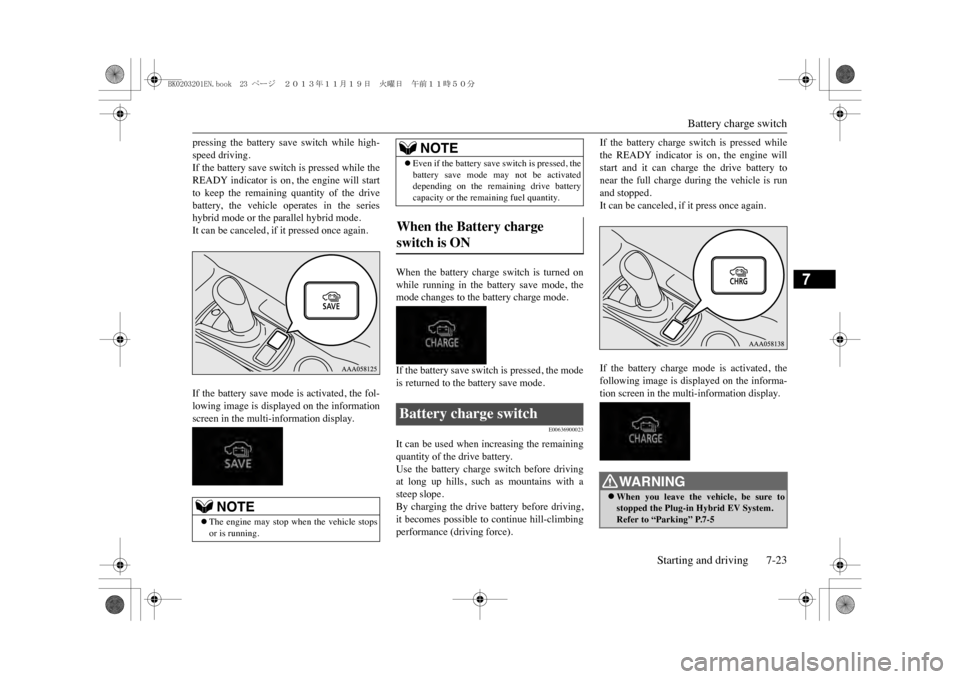
Battery charge switch
Starting and driving 7-23
7
pressing the battery save switch while high-speed driving.If the battery save switch is pressed while theREADY indicator is on, the engine will startto keep the remaining quantity of the drivebattery, the vehicle operates in the serieshybrid mode or the parallel hybrid mode.It can be canceled, if it pressed once again.If the battery save mode is activated, the fol-lowing image is displayed on the informationscreen in the multi-information display.
When the battery charge switch is turned onwhile running in the battery save mode, themode changes to the battery charge mode.If the battery save switch is pressed, the modeis returned to the battery save mode.
E00636900023
It can be used when increasing the remainingquantity of the drive battery.Use the battery charge switch before drivingat long up hills, such as mountains with asteep slope.By charging the drive battery before driving,it becomes possible to continue hill-climbingperformance (driving force).
If the battery charge switch is pressed whilethe READY indicator is on, the engine willstart and it can charge the drive battery tonear the full charge during the vehicle is runand stopped.It can be canceled, if it press once again. If the battery charge mode is activated, thefollowing image is displayed on the informa-tion screen in the multi-information display.
NOTE
�zThe engine may stop when the vehicle stopsor is running.
�zEven if the battery save
switch is pressed, the
battery save mode may not be activateddepending on the remaining drive batterycapacity or the remaining fuel quantity.
When the Battery charge switch is ON Battery charge switch
NOTE
WA R N I N G�zWhen you leave the vehicle, be sure tostopped the Plug-in Hybrid EV System.Refer to “Parking” P.7-5
BK0203201EN.book 23 ページ 2013年11月19日 火曜日 午前11時50分
Page 187 of 388
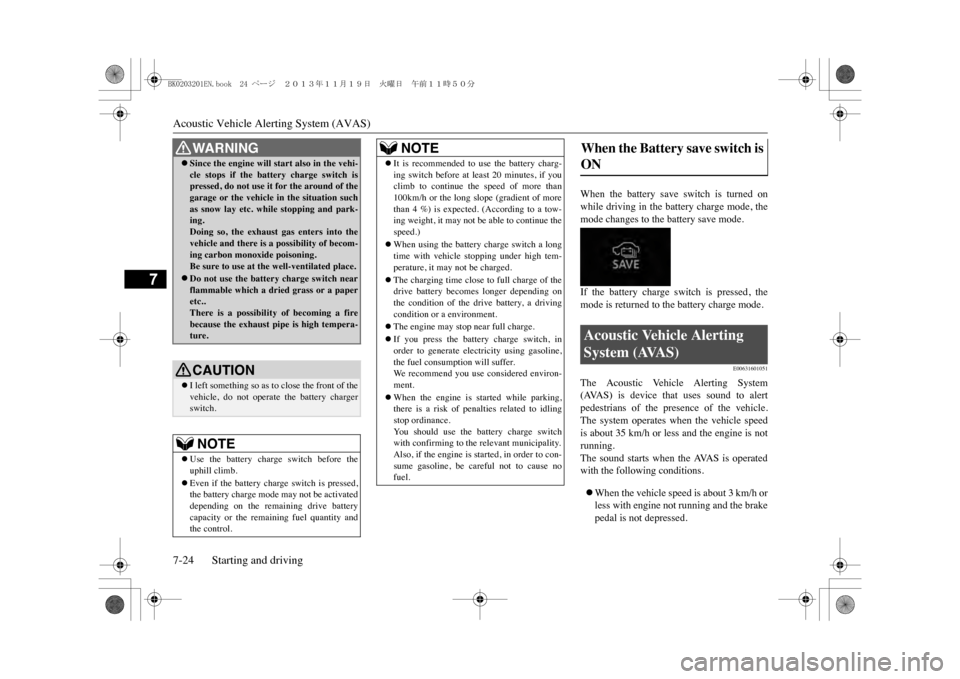
Acoustic Vehicle Alerting System (AVAS)7-24 Starting and driving
7
When the battery save switch is turned onwhile driving in the battery charge mode, themode changes to the battery save mode.If the battery charge switch is pressed, themode is returned to the battery charge mode.
E00631601051
The Acoustic Vehicle Alerting System(AVAS) is device that uses sound to alertpedestrians of the presence of the vehicle.The system operates when the vehicle speedis about 35 km/h or less and the engine is notrunning.The sound starts when the AVAS is operatedwith the following conditions.�zWhen the vehicle speed is about 3 km/h orless with engine not running and the brakepedal is not depressed.
�zSince the engine will start also in the vehi-cle stops if the batt
ery charge switch is
pressed, do not use it for the around of thegarage or the vehicle
in the situation such
as snow lay etc. while stopping and park-ing.Doing so, the exhaust gas enters into thevehicle and there is a possibility of becom-ing carbon monoxide poisoning.Be sure to use at the well-ventilated place.�zDo not use the battery charge switch nearflammable which a drie
d grass or a paper
etc..There is a possibility of becoming a firebecause the exhaust pipe is high tempera-ture.CAUTION�zI left something so as to close the front of thevehicle, do not operate the battery chargerswitch.NOTE
�zUse the battery charge switch before theuphill climb.�zEven if the battery charge switch is pressed,the battery charge mode may not be activateddepending on the remaining drive batterycapacity or the remaining fuel quantity andthe control.WA R N I N G
�zIt is recommended to use the battery charg-ing switch before at least 20 minutes, if youclimb to continue the speed of more than100km/h or the long slope (gradient of morethan 4 %) is expected. (According to a tow-ing weight, it may not be able to continue thespeed.)�zWhen using the battery charge switch a longtime with vehicle
stopping under high tem-
perature, it may not be charged.�zThe charging time close to full charge of thedrive battery becomes longer depending onthe condition of the drive battery, a drivingcondition or a environment.�zThe engine may stop near full charge.�zIf you press the battery charge switch, inorder to generate elec
tricity using gasoline,
the fuel consumption will suffer.We r e c o m m e n d y o u u s e c o n s i d e r e d e n v i r o n -ment.�zWhen the engine is started while parking,there is a risk of penalties related to idlingstop ordinance.Yo u s h o u l d u s e t h e b a t t e r y c h a r g e s w i t c hwith confirming to the relevant municipality.Also, if the engine is started, in order to con-sume gasoline, be careful not to cause nofuel.NOTE
When the Battery save switch is ON Acoustic Vehicle Alerting System (AVAS)
BK0203201EN.book 24 ページ 2013年11月19日 火曜日 午前11時50分
Page 188 of 388
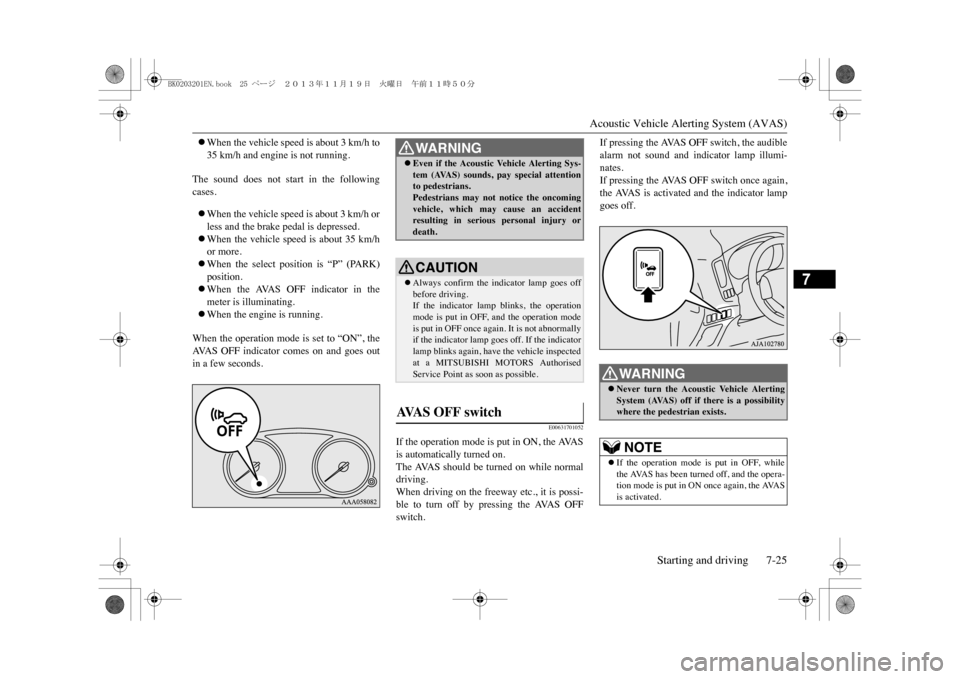
Acoustic Vehicle Alerting System (AVAS)
Starting and driving 7-25
7
�zWhen the vehicle speed is about 3 km/h to35 km/h and engine is not running.
The sound does not start in the followingcases. �zWhen the vehicle speed is about 3 km/h orless and the brake pedal is depressed.�zWhen the vehicle speed is about 35 km/hor more.�zWhen the select position is “P” (PARK)position.�zWhen the AVAS OFF indicator in themeter is illuminating.�zWhen the engine is running.
When the operation mode is set to “ON”, theAVA S O F F i n d i c a t o r c o m e s o n a n d g o e s o u tin a few seconds.
E00631701052
If the operation mode is put in ON, the AVASis automatically turned on.The AVAS should be turned on while normaldriving.When driving on the freeway etc., it is possi-ble to turn off by pressing the AVAS OFFswitch.
If pressing the AVAS OFF switch, the audiblealarm not sound and indicator lamp illumi-nates.If pressing the AVAS OFF switch once again,the AVAS is activated and the indicator lampgoes off.
WA R N I N G�zEven if the Acoustic Vehicle Alerting Sys-tem (AVAS) sounds, pay special attentionto pedestrians.Pedestrians may not notice the oncomingvehicle, which may cause an accidentresulting in serious
personal
injury or
death.CAUTION�zAlways confirm the indicator lamp goes offbefore driving. If the indicator lamp blinks, the operationmode is put in OFF, and the operation modeis put in OFF once again. It is not abnormallyif the indicator lamp goes off. If the indicatorlamp blinks again, have the vehicle inspectedat a MITSUBISHI MOTORS AuthorisedService Point as
soon as possible.
AVA S O F F s w i t c h
WA R N I N G�zNever turn the Acoustic Vehicle AlertingSystem (AVAS) off if there is a possibilitywhere the pedestrian exists.NOTE
�zIf the operation mode is put in OFF, whilethe AVAS has been turned off, and the opera-tion mode is put in ON once again, the AVASis activated.
BK0203201EN.book 25 ページ 2013年11月19日 火曜日 午前11時50分
Page 189 of 388
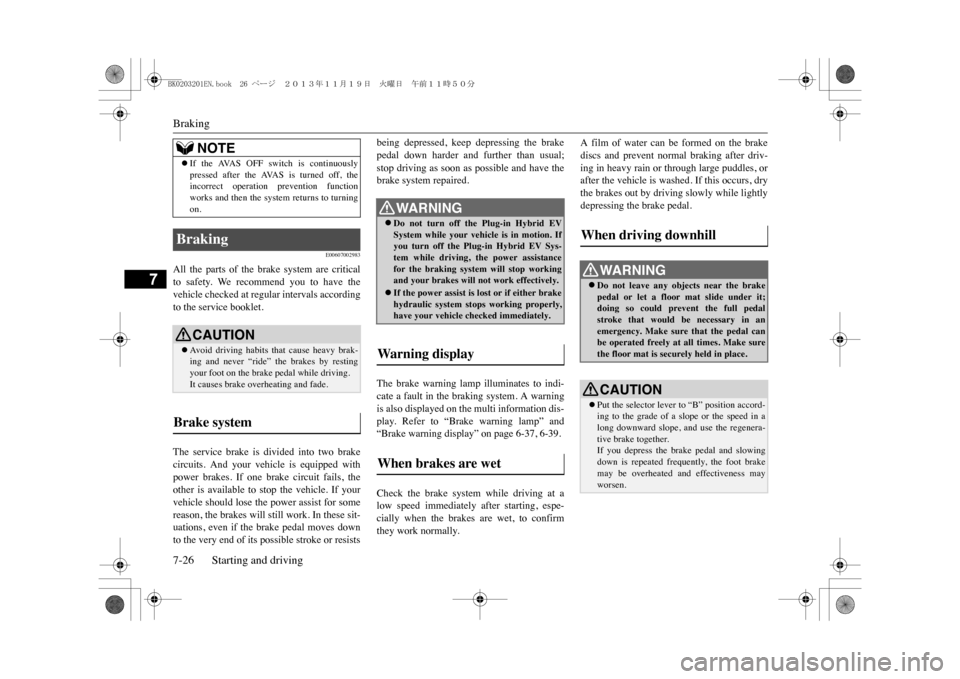
Braking7-26 Starting and driving
7
E00607002983
All the parts of the brake system are criticalto safety. We recommend you to have thevehicle checked at regular intervals accordingto the service booklet.The service brake is divided into two brakecircuits. And your vehicle is equipped withpower brakes. If one brake circuit fails, theother is available to stop the vehicle. If yourvehicle should lose the power assist for somereason, the brakes will still work. In these sit-uations, even if the brake pedal moves downto the very end of its possible stroke or resists
being depressed, keep depressing the brakepedal down harder and further than usual;stop driving as soon as possible and have thebrake system repaired.The brake warning lamp illuminates to indi-cate a fault in the braking system. A warningis also displayed on the multi information dis-play. Refer to “Brake warning lamp” and“Brake warning display” on page 6-37, 6-39.Check the brake system while driving at alow speed immediately after starting, espe-cially when the brakes are wet, to confirmthey work normally.
A film of water can be formed on the brakediscs and prevent normal braking after driv-ing in heavy rain or through large puddles, orafter the vehicle is washed. If this occurs, drythe brakes out by driving slowly while lightlydepressing the brake pedal.
�zIf the AVAS OFF switch is continuouslypressed after the AVAS is turned off, theincorrect operation prevention functionworks and then the system returns to turningon.
Braking
CAUTION�zAv o i d d r i v i n g h a b i t s t h a t c a u s e h e a v y b r a k -ing and never “ride” the brakes by restingyour foot on the brake pedal while driving.It causes brake overheating and fade.
Brake system
NOTE
WA R N I N G�zDo not turn off the Plug-in Hybrid EVSystem while your vehicle is in motion. Ifyou turn off the Plug-in Hybrid EV Sys-tem while driving, the power assistancefor the braking system will stop workingand your brakes will not work effectively.�zIf the power assist is lost or if either brakehydraulic system stops working properly,have your vehicle checked immediately.
Warn i ng d is p l a y When brakes are wet
When driving downhill
WA R N I N G�zDo not leave any obje
cts near the brake
pedal or let a floor mat slide under it;doing so could prevent the full pedalstroke that would be necessary in anemergency. Make sure that the pedal canbe operated freely at all times. Make surethe floor mat is securely held in place.CAUTION�zPut the selector lever to “B” position accord-ing to the grade of a slope or the speed in along downward slope, and use the regenera-tive brake together. If you depress the brake pedal and slowingdown is repeated frequently, the foot brakemay be overheated and effectiveness mayworsen.
BK0203201EN.book 26 ページ 2013年11月19日 火曜日 午前11時50分
Page 190 of 388
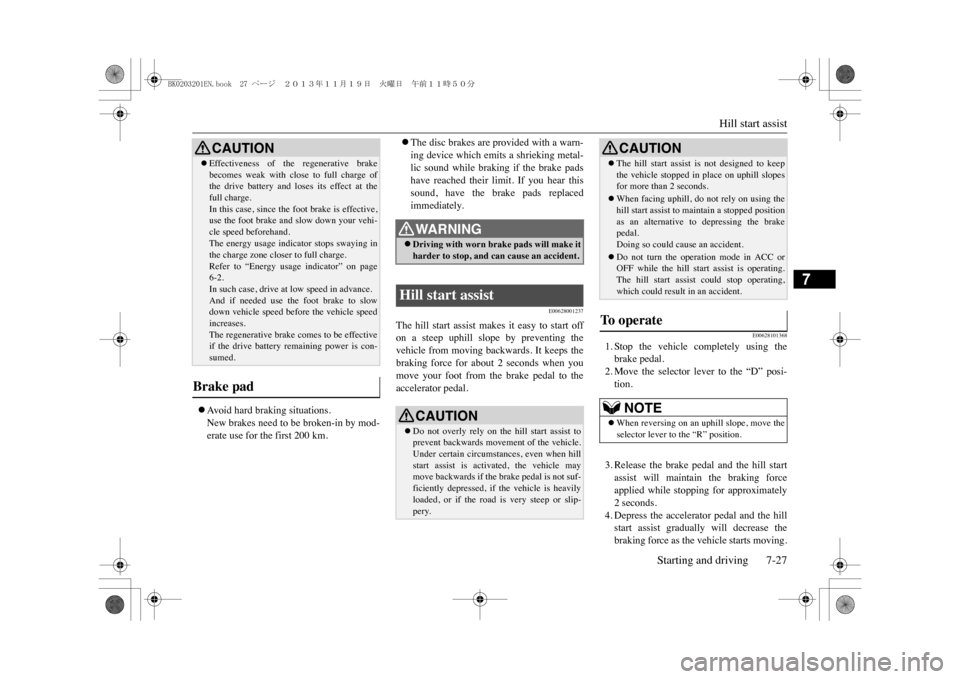
Hill start assist
Starting and driving 7-27
7
�zAv o i d h a r d b r a k i n g s i t u a t i o n s .New brakes need to be broken-in by mod-erate use for the first 200 km.
�zThe disc brakes are provided with a warn-ing device which emits a shrieking metal-lic sound while braking if the brake padshave reached their limit. If you hear thissound, have the brake pads replacedimmediately.
E00628001237
The hill start assist makes it easy to start offon a steep uphill slope by preventing thevehicle from moving backwards. It keeps thebraking force for about 2 seconds when youmove your foot from the brake pedal to theaccelerator pedal.
E00628101368
1. Stop the vehicle completely using thebrake pedal.2. Move the selector lever to the “D” posi-tion.3. Release the brake pedal and the hill startassist will maintain the braking forceapplied while stopping for approximately2 seconds.4. Depress the accelerator pedal and the hillstart assist gradually will decrease thebraking force as the vehicle starts moving.
�zEffectiveness of the
regenerative brake
becomes weak with close to full charge ofthe drive battery and loses its effect at thefull charge.In this case, since the
foot brake is effective,
use the foot brake and slow down your vehi-cle speed beforehand.The energy usage indicator stops swaying inthe charge zone closer to full charge.Refer to “Energy usag
e indicator” on page
6-2.In such case, drive at low speed in advance.And if needed use th
e foot brake to slow
down vehicle speed before the vehicle speedincreases.The regenerative brake comes to be effectiveif the drive battery re
maining power is con-
sumed.
Brake pad
CAUTION
WA R N I N G�zDriving with worn brake pads will make itharder to stop, and can cause an accident.
Hill start assist
CAUTION�zDo not overly rely on the hill start assist toprevent backwards movement of the vehicle.Under certain circumstances, even when hillstart assist is activated, the vehicle maymove backwards if the brake pedal is not suf-ficiently depressed, if the vehicle is heavilyloaded, or if the road is very steep or slip-pery.
�zThe hill start assist is not designed to keepthe vehicle stopped in place on uphill slopesfor more than 2 seconds.�zWhen facing uphill, do not rely on using thehill start assist to maintain a stopped positionas an alternative to depressing the brakepedal.Doing so could cause an accident.�zDo not turn the operation mode in ACC orOFF while the hill start assist is operating.The hill start assist could stop operating,which could result in an accident.
To o p e r a t e
NOTE
�zWhen reversing on an uphill slope, move theselector lever to the “R” position.CAUTION
BK0203201EN.book 27 ページ 2013年11月19日 火曜日 午前11時50分